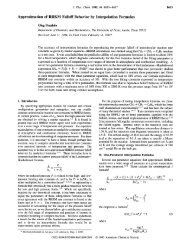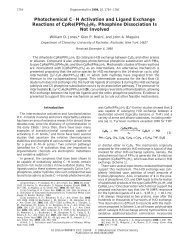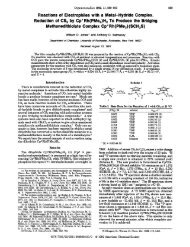Organometallics 2010, 29, 2430â2445 - Chemistry - University of ...
Organometallics 2010, 29, 2430â2445 - Chemistry - University of ...
Organometallics 2010, 29, 2430â2445 - Chemistry - University of ...
Create successful ePaper yourself
Turn your PDF publications into a flip-book with our unique Google optimized e-Paper software.
Article <strong>Organometallics</strong>, Vol. <strong>29</strong>, No. 11, <strong>2010</strong> 2435<br />
Scheme 1. Reactions <strong>of</strong> [(dippe)NiH] 2 with 1-Cyanonaphthalene, 2-Cyanonaphthalene, 1-Cyano-4-methylnaphthalene, and 1,4-Dicyanonaphthalene<br />
single-crystal structures <strong>of</strong> C1, C3, andC4 were described<br />
in an earlier report. 6b<br />
The results from DFT calculations (Figure 6) show that the<br />
η 2 -arene complex SC2 is connected to the η 2 -nitrile SC1 by<br />
transition state TSC12 and to the oxidative addition product<br />
SC3 by another transition state, TSC23, as with the other<br />
dicyanobenzenes. TSC12 and TSC23 have structures similar<br />
to TSA12 and TSA25. In calculating the fluxional process, if the<br />
nickel migrated via η 3 -allyl-like transition states as before, it<br />
would equilibrate the two phosphorus environments as nickel<br />
moves from one cyano-substituted double bond to the other (see<br />
Supporting Information weo). This pathway includes another<br />
η 2 -arene complex with an energy higher than SC2 by 3.3 kcal<br />
mol -1 , in which nickel coordinates to the central double bond<br />
and has a fluxional barrier <strong>of</strong> 12 kcal mol -1 (see Figure SI-4). As<br />
this pathway is in contradiction with the observed phosphorus<br />
data, another migration mode was modeled in which nickel<br />
migrates between C2 and C2 0 via a single η 4 -coordinated<br />
transition state, TS22 0 _2 (eq 9). This migration pathway has a<br />
Figure 7. ORTEP drawing <strong>of</strong> (dippe)Ni(C 10 H 7 )(CN) (D13).<br />
Ellipsoids are shown at the 50% probability level. Selected bond<br />
lengths (A˚ ): Ni(1)-C(1), 1.872(4); Ni(1)-C(2), 1.953(5); Ni(1)-<br />
P(1), 2.1949(12); Ni(1)-P(2), 2.1805(11); C(1)-N(1), 1.138(5).<br />
Selected angles (deg): P(1)-Ni(1)-P(2), 87.48(4); C(2)-Ni(1)-<br />
C(1), 89.27(18); N(2)-C(8)-Ni(1), 175.3(4).<br />
lower energy barrier and does not equilibrate the phosphorus<br />
environments. (Figure 6 and weo in Supporting Information).<br />
The change from [1,2] to [1,3] shifts around the ring can be<br />
attributed to the preference for binding to a double bond<br />
substituted with a cyano group.<br />
For the dicyanobenzenes, the C-CN bond cleavage still<br />
occurs in the same way as with benzonitrile, i.e., via an η 2 -C,<br />
C adduct. For the fluxional η 2 -arene intermediates, however,<br />
the migration mode <strong>of</strong> nickel metal varies from η 2 f [η 3 ] q f<br />
η 2 to η 2 f [η 4 ] q f η 2 and results in different behaviors in the<br />
low-T 31 P NMR spectra.<br />
Reaction with Cyanonaphthalenes and Derivatives. To<br />
compare the reactivity <strong>of</strong> polycyclic aromatic nitriles for
















